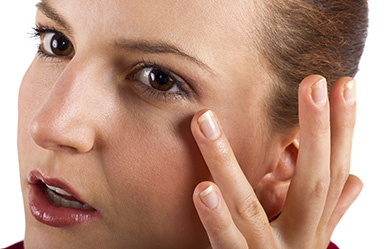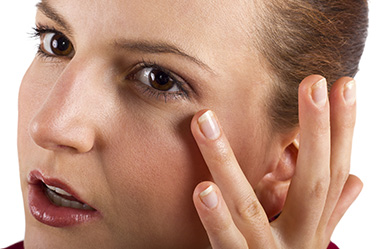
The ‘tear troughs’ are the depressions running from the nose up to the under-eye area. Over time, this area of the face tends to sag into wrinkles, and dark circles or hollowing may appear. Dark under-eye bags are a common concern and can make a person look older or more tired than they really are.
There are many causes of tear trough imperfections: genetics, lack of sleep, lifestyle and ageing all contribute.
Sagging can be caused by the loss of facial fat in the under-eye and cheek area, as well as bone loss. It can also result from loosening ligaments. Some people are simply born with a shallow bone structure and lack of fat in this area.
People may opt for a lower blepharoplasty (lower eye lift) to resolve the issue, but not everyone is suitable for this surgery, as it can create a ‘hound dog’ look. Others simply do not want to experience the invasiveness or expense of such a procedure.
A non-surgical tear trough treatment can provide an excellent alternative, involving the injection of dermal filler above the eye socket bone. This filler is then massaged into the fatty tissues underneath the eye, filling in this depression from inside the skin.
The treatment can rejuvenate the appearance of this area by plumping up hollow under-eye areas, while concealing dark circles by filling in the loose skin.
However, if a person is not a suitable candidate for dermal fillers in this area, if too much or a too-thick filler is used, or an injector is not sufficiently knowledgeable, skillful or artistic, the problem can be made a whole lot worse.
Eyes can develop even bigger-looking ‘bags’ due to accumulation of fluid in the humectant hyaluronic acid (HA) filler, and the way light reflects off existing HA fillers can contribute to a blueish tinge (thus exaggerating rather than diminishing dark shadows).
A new filler, Teosyal Redensity II, launched at Cosmetex in Melbourne (April 30-May 2), promises to negate these possible side effects, offering new hope for patients plagued by under-eye hollows and/or dark circles, whatever their age. However, most candidates for this treatment are in their mid-30s or older.
‘Tear troughs are a common problem worldwide,’ says Dr Hassan Galadari, a leading dermatologist from Dubai who attended Cosmetex to launch the product and hold training workshops for doctors and nurse injectors. ‘But nobody talks about them; nobody tackles them, because to date there’s been no really effective product.
‘The molecular structure of Teosyal Redensity II provides the physical properties of a soft HA and the longevity of more durable fillers such as Radiesse (calcium hydroxylapatite/CaHA; Merz Aesthetics).
‘The tear trough has proven difficult to treat partly because the skin in this area is extremely thin and translucent.
‘Using popular HA fillers approved by the US Food and Drug Administration (FDA) can potentially lead to lumps or a bluish appearance under the skin in treated areas due to the Tyndall effect [light scattering by particles, named after 19th century physicist John Tyndall]. This results from light reflecting off the clear HA gel.
‘Likewise, the vascularity of the tear trough area means that physicians must inject carefully or risk creating bleeding and bruising. Additionally, cases of blindness have occurred due to embolisms in these vessels.’
Further challenges stem from the fact that no FDA-approved fillers are indicated for the tear troughs, Dr Galadari says.
‘In the US, the current trend is to dilute any of the HA fillers with lidocaine [a commonly used local anaesthetic] to decrease the probability of the Tyndall effect.
‘This practice makes the fillers easy to inject [but] using such high concentrations of lidocaine biochemically alters the HA and shortens its longevity.
‘The key to HA’s longevity is its chemical makeup, the way that it’s cross-linked. If you break these cross-links with a lot of dilution, you end up with an HA that’s not going to last long.
‘Teosyal Redensity II is composed of both cross-linked and non-cross-linked HA, in addition to amino acids and minerals. This creates a product that lasts for an average of a year. And no matter the quantity injected, it does not lead to any swelling or Tyndall effect.’
Dr Galadari explained to SPA+CLINIC that, where most existing HA fillers ‘sit’ on top of the tissue, Redensity II integrates with it, thus also minimising the side effects that can be experienced with other fillers in the tear trough region.
Regarding treatment technique, Dr Galdari says: ‘It’s injected the same way as any other filler; with a needle or cannula. It’s usually placed deeply, right on the inferior orbital rim. Then you massage it to achieve the desired contour. (Click here to watch Dr Galadari in action.)
‘Relatively non-hygroscopic [ie. not as likely to absorb or attract moisture from the air], Teosyal Redensity II will not absorb water from surrounding tissues, which is what can produce swelling with other HA products.
‘Because the product provides 1:1 correction, there’s no need to overcorrect. Patients require a very small amount – usually 0.5ml per side.
‘There’s no swelling whatsoever and none of my patients have developed lumps. [If patients somehow develop problems of this type, he notes that physicians can reverse the treatment with hyaluronidase.]
‘As with other HAs, he says, injecting with a needle can produce bruising. Apart from that, there are no major drawbacks.
‘Everybody I have injected has liked it, especially since it also contains lidocaine, making it a relatively pain-free procedure.’
As for patient selection, Dr Galadari says the product works well for virtually anyone concerned about tear troughs – except for those with more serious issues such as fat hypertrophy or significant eyelid sagging, both of which require blepharoplasty surgery.




